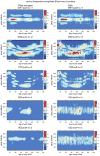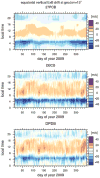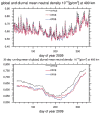Thermosphere-Ionosphere-Electrodynamics General Circulation Model for the Ionospheric Connection Explorer: TIEGCM-ICON
- PMID: 30026634
- PMCID: PMC6047070
- DOI: 10.1007/s11214-017-0330-3
Thermosphere-Ionosphere-Electrodynamics General Circulation Model for the Ionospheric Connection Explorer: TIEGCM-ICON
Abstract
The NASA Ionospheric Connection explorer (ICON) will study the coupling between the thermosphere and ionosphere at low- and mid-latitudes by measuring the key parameters. The ICON mission will also employ numerical modeling to support the interpretation of the observations, and examine the importance of different vertical coupling mechanisms by conducting numerical experiments. One of these models is the Thermosphere-Ionosphere-Electrodynamics General Circulation Model-ICON (TIEGCM-ICON) which will be driven by tidal perturbations derived from ICON observations using the Hough Mode Extension method (HME) and at high latitude by ion convection and auroral particle precipitation patterns from the Assimilative Mapping of Ionospheric Electrodynamics (AMIE). The TIEGCM-ICON will simulate the thermosphere-ionosphere (TI) system during the period of the ICON mission. In this report the TIEGCM-ICON is introduced, and the focus is on examining the effect of the lower boundary on the TI-system to provide some guidance for interpreting future ICON model results.
Keywords: ICON explorer; atmospheric tides; numerical modeling.
Figures




















References
-
- Akmaev RA, Shved GM. Modelling of the composition of the lower thermosphere taking account of the dynamics with applications to tidal variations of the forbidden O I 5577 A airglow. Journal of Atmospheric and Terrestrial Physics. 1980;42:705–716.
-
- Alken P, Chulliat A, Maus S. Longitudinal and seasonal structure of the ionospheric equatorial electric field. Journal of Geophysical Research: Space Physics. 2013;118(3):1298–1305. doi: 10.1029/2012JA018314. - DOI
-
- Burns AG, Solomon SC, Wang W, Qian L, Zhang Y, Paxton LJ. Daytime climatology of ionospheric NmF2 and hmF2 from COSMIC data. Journal of Geophysical Research: Space Physics. 2012;117(A9) doi:10.1029/2012JA017529, a09315.
-
- Dickinson RE, Ridley E, Roble R. Thermospheric general circulation with coupled dynamics and composition. Journal of the Atmospheric Sciences. 1984;41(2):205–219.
-
- Drob DP, et al. An empirical model of the earth’s horizontal wind fields: Hwm07. Journal of Geophysical Research: Space Physics. 2008;113(A12) doi:10.1029/2008JA013668, a12304.
Grants and funding
LinkOut - more resources
Full Text Sources
Other Literature Sources
